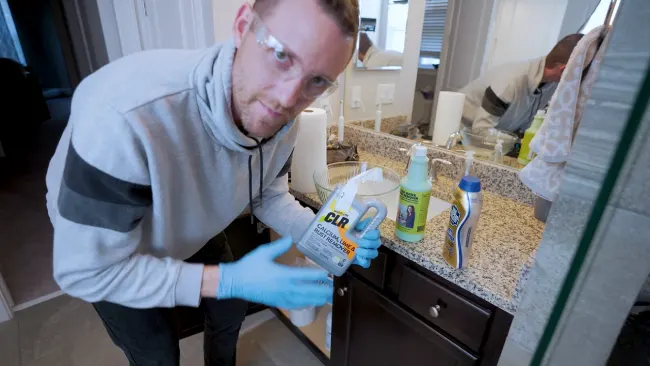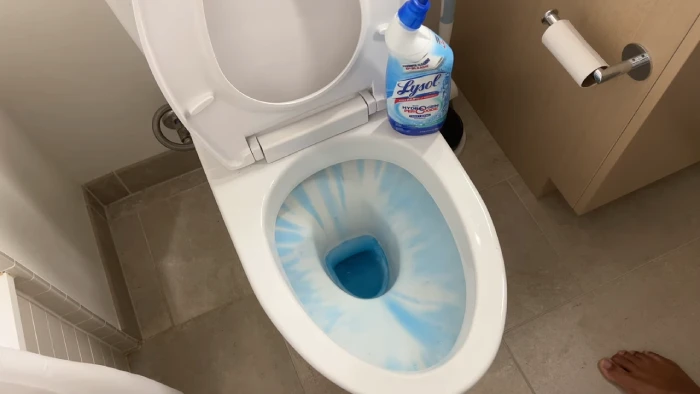Last Updated on November 14, 2023
Toilet cleaners are ubiquitous in our daily cleaning routines, ensuring our bathrooms remain hygienic and free from unpleasant odors. But, these household products may pose a significant risk to human health if misused or ingested accidentally. There’s the question, is toilet cleaner poisonous?
While they may appear harmless to the naked eye, toilet cleaners contain potent chemicals that can be highly toxic when consumed or inhaled.
Some key ingredients found in toilet cleaners include bleach (sodium hypochlorite), ammonia, hydrochloric acid, sodium hydroxide, sodium lauryl ether sulfate (SLES), cetrimonium chloride (CTAC), fragrances and dyes.
Let’s discuss the possible dangers associated with toilet cleaners. Also, we address the consequences of getting toilet bowl cleaner in one’s mouth.
What Are The Poisonous Ingredients in Toilet Cleaners & Their Effects?

Toilet cleaners contain several ingredients that are poisonous if ingested or inhaled. Most toilet cleaner formulations contain the following ingredients:
- Bleach (Sodium Hypochlorite)
- Ammonia
- Hydrochloric Acid
- Sodium Hydroxide
- Sodium Lauryl Ether Sulfate (SLES)
- Cetrimonium Chloride (CTAC)
- Fragrances and Dyes
No 01: Bleach (Sodium Hypochlorite)
Sodium hypochlorite, commonly known as bleach, is a powerful disinfectant that effectively removes stains and kills germs from various surfaces. It is the main active ingredient in many toilet cleaners due to its ability to whiten and brighten porcelain bowls.
Mixing bleach with ammonia or acids such as vinegar can create dangerous chemical reactions that produce toxic gasses like chlorine gas. In extreme cases, this can lead to respiratory problems, eye irritation, coughing, nausea, and even death.
So read the labels of toilet cleaners carefully and avoid mixing different products together to prevent harmful consequences.
No 02: Ammonia
This ingredient is widely used in toilet cleaning products due to its potent efficacy in removing stubborn stains and bad odors. Despite its effectiveness, ammonia is also known to pose significant risks to health.
Skin irritation and respiratory issues are common side effects of ammonia exposure, and when mixed with acidic or bleach-based cleaning agents, it can produce toxic gasses.
And mixing ammonia with hydrochloric acid, bleach or other chemicals can produce harmful gasses that pose a serious risk to health.
No 03: Hydrochloric Acid
The chemical hydrogen chloride is commonly used in toilet bowl cleaners to dissolve mineral deposits, hard water stains, and rust. You can get hurt with it if you don’t handle it right. It can release toxic gases such as chlorine gas if mixed with other chemicals like bleach or ammonia.
When handling hydrochloric acid, you need to be extremely careful. The acid can potentially cause severe chemical burns if it comes into contact with the skin, eyes, or mucous membranes. Moreover, inhaling its fumes can irritate the respiratory system, leading to coughing, shortness of breath, or chest pain.
No 04: Sodium Hydroxide
Caustic sodium hydroxide, commonly used in cleaning products, poses significant health risks due to its corrosive properties. This alkaline substance, commonly found in toilet cleaners, can cause severe skin and eye irritation upon contact and respiratory issues if inhaled.
If released into waterways or soil, it can harm aquatic life by raising pH levels. So, it is no surprise that sodium hydroxide products require extreme caution.
Although this chemical can efficiently tackle stubborn stains and clogs in toilets, the potential risks associated with using it far outweigh the benefits. Due to this, it’s wise to consider safer alternatives to cleaning toilets and other household stuff.
No 05: Sodium Lauryl Ether Sulfate (SLES)
Toilet cleaning products often contain sodium Lauryl Ether Sulfate (SLES) for its foaming and cleaning properties. Even so, it poses health and environmental risks. While SLES itself is not highly toxic, it causes skin and eye irritation, specifically for individuals with sensitive skin.
There are also concerns about its ability to generate carcinogenic compounds when mixed with other chemicals present in cleaning products. Some manufacturers have opted to switch to cetrimonium chloride as an alternative surfactant to alleviate these concerns. It does not have the same level of toxicity risks as SLES.
No 06: Cetrimonium Chloride (CTAC)
This ingredient, CTAC, is a frequently employed quaternary ammonium compound in cleaning products and is especially prevalent in many toilet cleaners. This is due to its ability to diminish static electricity, boost product texture, and benefit surface conditioning.
Generally, CTAC is deemed to be safe, but excessive concentrations or extended exposure can elicit skin and eye irritations. Those with pre-existing allergies or sensitivities to quaternary ammonium compounds should use caution when utilizing CTAC products.
No 07: Fragrances and Dyes
Toilet cleaners often contain fragrances and dyes that improve their aesthetic appeal. But, using these additives can lead to adverse skin reactions or allergies due to the chemicals they contain. Even at low concentrations, prolonged exposure to fragrances and dyes may cause inflammation and skin irritation.
Ingestion of toilet cleaners containing these additives can lead to gastrointestinal issues, as they are not intended for human consumption. Ensure you store toilet cleaners in a secure location, away from the reach of children and pets.
What happens if you get toilet bowl cleaner in your mouth?

Exposure to toilet bowl cleaner is harmful when accidentally ingested. The chemicals in toilet bowl cleaners are potent and can cause severe damage to the mouth and respiratory system. Ingestion of the cleaner could lead to chemical burns in the oral cavity and throat.
People who ingest toilet bowl cleaners may experience chest pain, vomiting, difficulty breathing, and loss of consciousness. If inhaled, the toxic fumes from the cleaner can irritate the lungs and cause respiratory distress.
Whenever you suspect that you or someone you know has ingested or inhaled toilet bowl cleaner, seek immediate medical attention. Acting quickly can prevent further complications and ensure the highest recovery chances.
Remember, the most effective way to prevent this type of incident is carefully and safely storing cleaning products out of reach of children and pets.
Don’t Take Risks with Toilet Bowl Cleaners: Follow Safety Guidelines to Stay Safe
Toilet cleaners often contain hazardous chemicals such as hydrochloric acid, sodium hypochlorite, and chlorine gas. These ingredients are toxic if ingested or come into contact with skin or eyes. Inhaling the fumes from the cleaners can also cause respiratory problems.
When misused, a toilet bowl cleaner is extremely harmful and even fatal. If someone accidentally ingests toilet bowl cleaner, they may experience symptoms such as nausea, vomiting, abdominal pain, difficulty breathing, and in severe cases, seizures or coma. In these situations, you need medical attention right away.
It’s crucial to handle toilet bowl cleaners carefully and follow all safety directions the manufacturer provides. Ignoring these instructions could put you and your loved ones at risk. When it comes to using toilet bowl cleaners, remember safety first.


